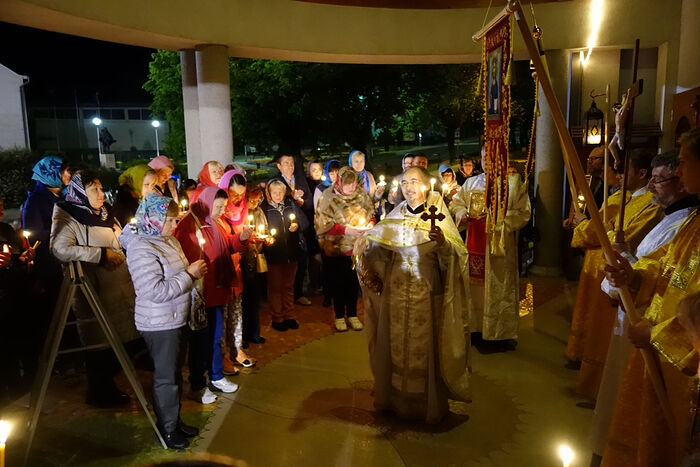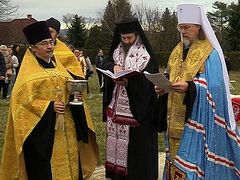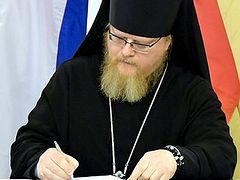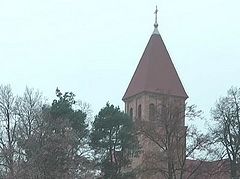—Do you keep in touch with your homeland at the parish level? Are there any joint events, for example, with parishes from Russia?
—We still don’t have regular joint programs, but many parishes in Russia, Ukraine, Moldova, Belarus and their rectors help us with literature and church items. In 2014, our parish organized a pilgrimage trip to Russia for a group of Catholic clergy headed by Fr. Laszlo Kiss, the Dean of Heviz, as a token of gratitude for his hospitality because our parish had served in his church for the first few years. Together with him several teachers and priests from the Catholic University in Veszprem visited St. Petersburg. In Russia they were received by Archpriest Seraphim Sologub, rector of the Ascension Church in Kolpino where I started my ministry, and the Parish Council Secretary Elena Peters was the interpreter. The pilgrims visited the newly-restored church in Kronstadt, along with Tsarskoye Selo, Kolpino and Peterhof. They had very good impressions of Russia and the sincere faith of its people, which they later shared in a Hungarian television report. Dean Laszlo Kiss still recalls this trip and gives his compliments to Archpriest Seraphim.
There was another visit when a group of pilgrims from the Kazan Cathedral of St. Petersburg travelled to Hungary and visited its shrines and Orthodox churches, which can be found in the booklet, Orthodox Hungary. In 2014, I wrote this short illustrated guide to the interesting sites of Hungary associated with Orthodoxy and it was published by the Robinson Tours travel agency.
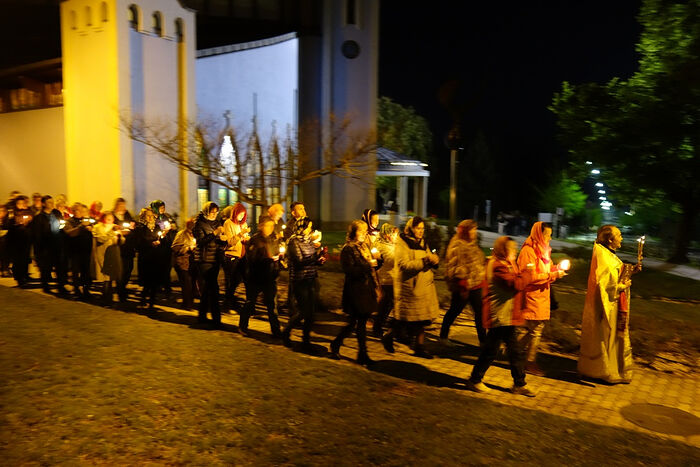 The Paschal cross procession in Heviz
The Paschal cross procession in Heviz
—Do you interact with representatives of other denominations and religions?
—For several years Orthodox services were held in Catholic churches of Heviz by agreement between the then Administrator of the Dioceses of Austria and Hungary, Metropolitan Mark (Golovkov), and Archbishop Gyula (Marfi) of Veszprem. This was not a formal gesture on the Catholics’ part, but a manifestation of Christian mutual aid and a keen interest in Orthodoxy. The Catholic priest who allowed us to hold night services at Christmas and Pascha even lamented that in Hungary, the tradition of night services was abandoned in the Soviet era and has since been forgotten. In the first year, the Paschal night procession surprised the locals; the mayor’s office took care for the safety of several hundred worshippers by sending a police squad to the church, but everything was orderly, solemn and beautiful. So, the law-enforcement agencies didn’t bother in years after that.
A fruitful cooperation is possible provided that there is mutual interest, and a striking example of this is the Benedictine monastery in Tihany. I have already mentioned it and its abbot. He always gladly received us and allowed us to hold Orthodox services annually in the crypt of the monastery church at the tomb of King Andrew I, recording these events in the monastery chronicle. Now the new abbot, Fr. Jerome, also tries to maintain good relations with the Orthodox. On September 3 of this year, Tihany hosted a concert of the Synodal Choir conducted by Alexei Puzakov, and the performance was a great success. On October 2, the abbey hosted the Opening of the Fourth Festival of Russian Music with a piano concert, which included works by Tchaikovsky, Prokofiev and Mussorgsky, performed by the Hungarian pianist Marcell Szabo. The Heviz parish together with representatives of the Russian Embassy also took part in these cultural events.
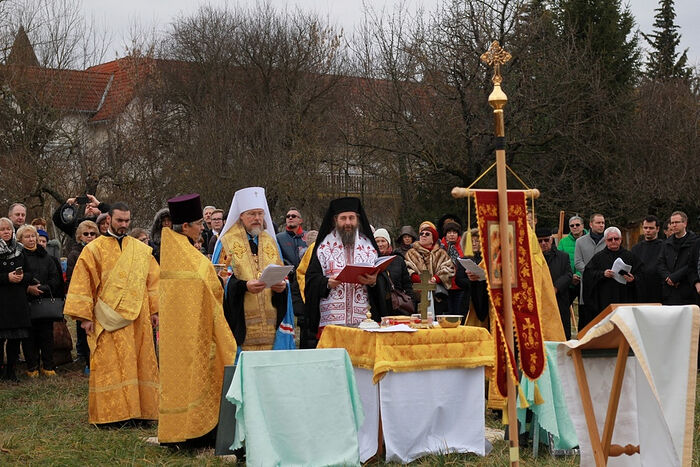 Metropolitan Mark (Golovkov) performs the rite of placing the church cornerstone, 2019
Metropolitan Mark (Golovkov) performs the rite of placing the church cornerstone, 2019
—How are relations with the authorities developing? Is there any support from the State?
—The Orthodox, including those under the jurisdiction of the Moscow Patriarchate, have the same rights and obligations to the State as the Catholics and Protestants of Hungary, and in recent years the State has provided significant material support to the historical Churches. In fact, the Hungarian Government financed the construction of our church. On March 9, 2017, a solemn agreement was signed on the allocation of a State subsidy to the Hungarian Diocese of the Russian Orthodox Church for the restoration of three Orthodox churches and the construction of a new church. It was signed by Bishop Tikhon (Zaitsev, now Archbishop of Berlin and Germany) of Podolsk, Administrator of the the Dioceses of Austria and Hungary, and Zoltan Balog, the then Minister of Human Resources of Hungary. The subsidy was allocated for the restoration of the Dormition Cathedral in Budapest, the Holy Trinity Church in Miskolc, the St. Nicholas Church in Tokaj and the construction of a new Orthodox church in Heviz. The State Secretary for National Minorities Mr. Miklos Šoltes repeatedly visited the construction site in Heviz and spoke very kindly of the future Orthodox church in the Hungarian press, emphasizing the need for the construction of a parish house.
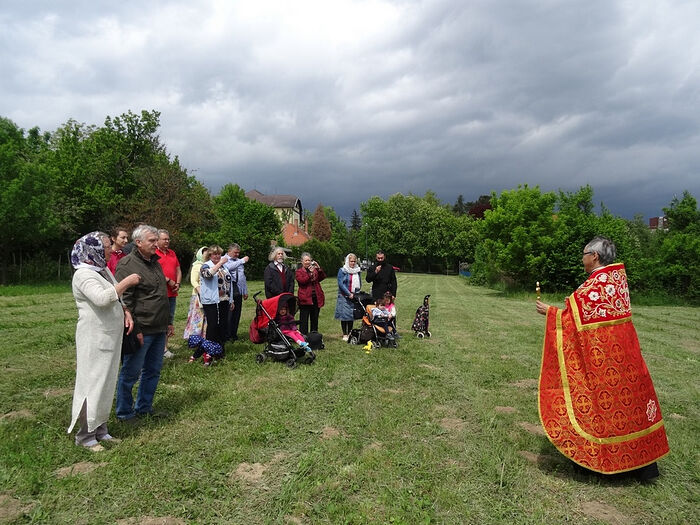 A prayer service on the site of the future church
A prayer service on the site of the future church
The parish takes part in the events of Zala County. With the deputy governor’s permission the parish celebrates services in the Zalavar Museum Complex—on the soil sanctified by the prayers of Sts. Cyril and Methodius. We got permission to install a temporary wooden iconostasis in the museum complex’s church, built in 2017 by the Nemeth-fa Hungarian company using my design. The iconostasis is in the shape of the Glagolitic letter “Л”, which means “People” and “Love” (“Lyudi” and “Lyubov”). Over the years it has become a local landmark.
This kind attitude on the part of Hungarian authorities towards Russian culture and spiritual traditions is highly appreciated in Russia. During a visit to Moscow of the representative delegation from Hungary in early October this year, the Mayor of Heviz Mr. Papp Gabor received a Russian public award for aid in the construction of an Orthodox church—the Grand Cross of the Orthodox Russia movement.
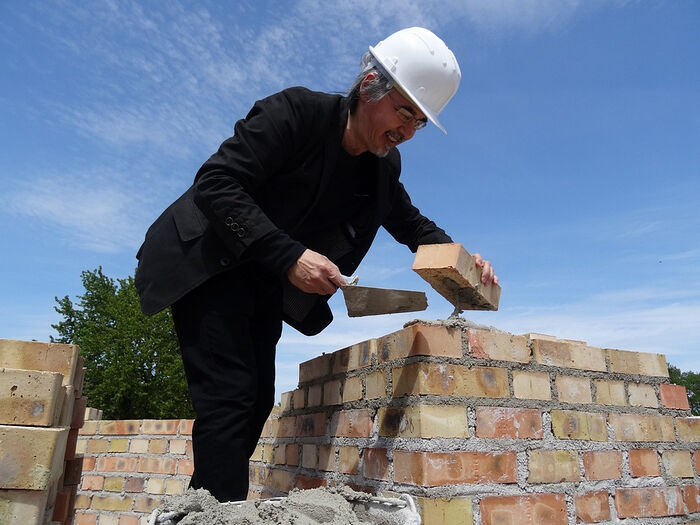 At the church construction site. 2020
At the church construction site. 2020
—Today Hungary is considered one of the strongholds of conservative values in Europe, along with Poland and Slovakia, in opposition to the EU agenda. What is the reason behind that?
—I don’t know the situation in Poland and Slovakia in detail, although I have heard about these countries’ leaders’ positions. I can speak more precisely about Hungary because I see the situation from the inside. The world is going through a crisis; and I won’t list the many challenges that modern civilization is faced with. Any crisis reveals the essence of things and various phenomena. Today in Hungary, the deep, core national traits are manifesting themselves.
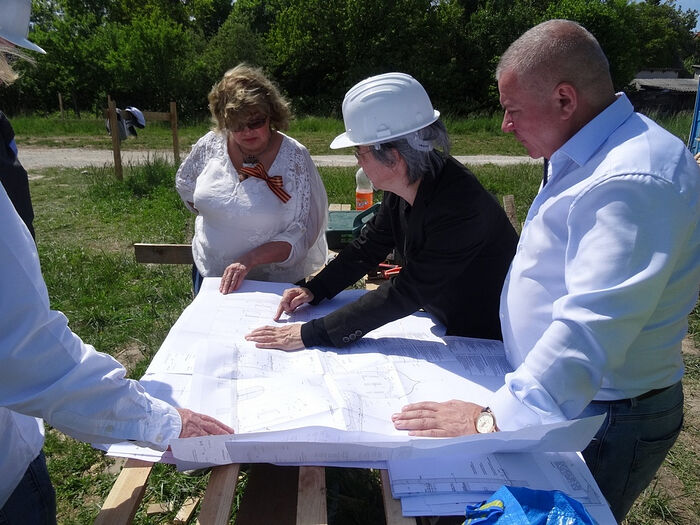 A working meeting at the construction site. 2020
A working meeting at the construction site. 2020
—Which traits, for example?
—As it turns out, they are the opposite of what is favored by today’s Europe. This is independence, loyalty to one’s history, traditions, preserving the spiritual and cultural heritage of ancestors, and most importantly, standing firm in the faith. Here is an amazing historical fact: For over a millennium the Hungarians, being in close contact with the Germanic and Slavic countries and often in a subordinate position, didn’t assimilate and retained their language and national character. By the way, they well remember that they came from beyond the Urals, so they retained their strong Siberian character. Unlike some new European countries, the history of Hungary is that of the struggle for freedom, independence, and its own statehood. And modern Hungary isn’t going to give up its real—not imaginary—independence so easily. In addition to its strong character, modern Hungary fortunately has a worthy leader. Although Viktor Orban is the leader of a relatively small country by the standards of the EU, he is nevertheless the informal leader of all the healthy, traditional forces in Europe. The Hungarian Government supports Christians with concrete deeds not only within the country, but also abroad. And this policy—healthy, moral and understandable for most people—enjoys unwavering support from the population.
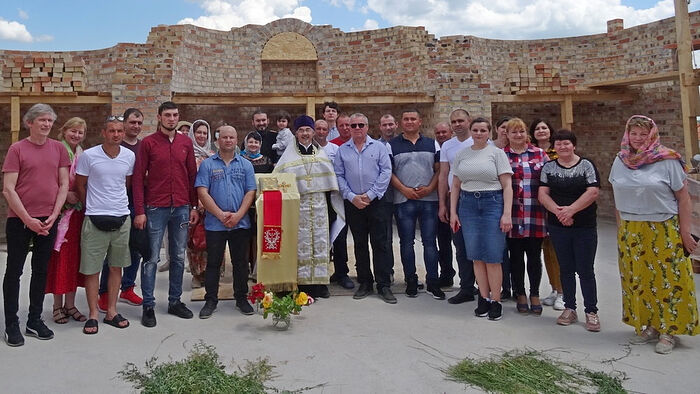 With builders and parishioners after a service. 2020
With builders and parishioners after a service. 2020
—What you said about Orban is interesting. What kind of obedience do you perform besides pastoring the parish?
—I am the administrator and technical editor of the diocesan website and the network of parish websites of the diocese of Hungary. I also do research work. The results of my historical and archival research are collected in my doctoral thesis entitled, “The Phenomenon of Russian Orthodoxy in the Hungarian Land,” which I defended this year at the Department of Orthodox Theology at University of Presov (Slovakia). The department’s academic council recommended this work for publication in the form of a book, possibly for a lecture course based on it. I hope this book will be published soon, although I have a number of popular articles on this topic published in Hungary for You magazine; they are posted on my personal website as well.
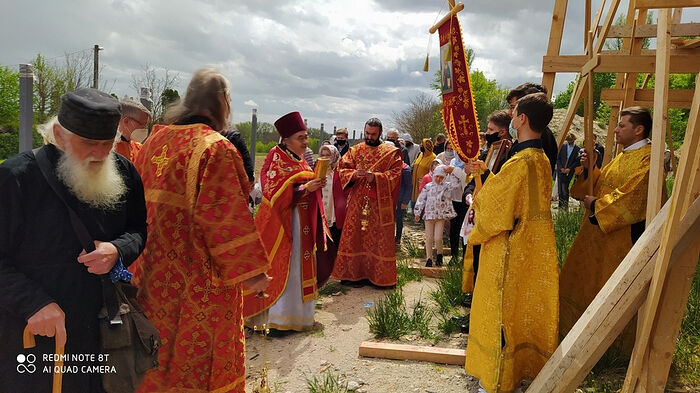 The Paschal cross procession around the church under construction. 2021
The Paschal cross procession around the church under construction. 2021
—What serious spiritual questions from the parishioners do you as a pastor encounter in your ministry?
—People are more interested in their personal concerns and problems, including in the spiritual life, and this is natural. But among the endless variety of topics I can single out a number of common ones concerning our faith, responses to the challenges of the time, the crisis of the modern worldview and internal Church issues. People are worried about the aggressive secularization imposed by the media and the lack of spirituality in media culture. Many people perceive the inter-Orthodox conflict, the openly secular position of the hierarchs of a number of Local Churches who recognize schismatics with aching hearts. We are used to close, truly fraternal relations with the Greek clergy—many of us have visited the holy sites of Greece, Mt. Athos and Corfu. They went there with fervent faith and reverence for the holy places, prayed and received Communion. Our parishioners have taken the recent rupture in Eucharistic communion with the Patriarchate of Constantinople with a heavy heart. Of course, everyone supports the wise policy of our Church hierarchy, and they follow the advice of His Holiness Patriarch Kirill regarding our Orthodox brothers. But unfortunately, now as parting words before pilgrimages to holy places we have to call people to prayer for the Orthodox hierarchs who have gone astray to come to their senses.
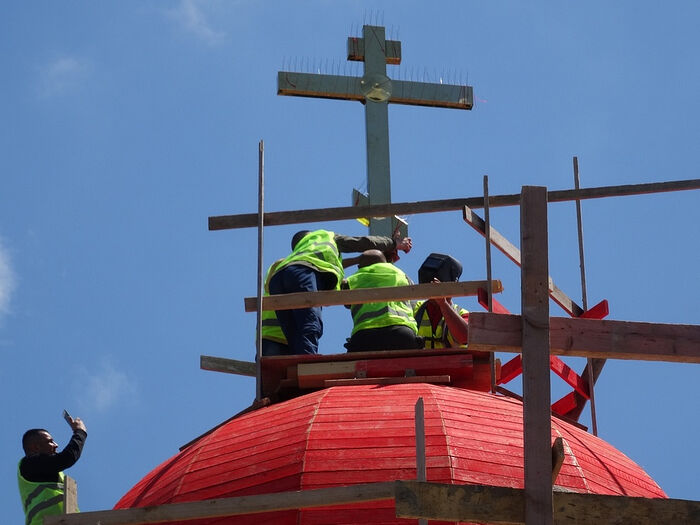 The Installation of the cross on the church dome. 2021
The Installation of the cross on the church dome. 2021
—What do you regard as the challenge of the time for an Orthodox Christian?
—The world is changing so rapidly and the means of communication have reached such a level that one cannot talk about the challenges of the time for a particular country or place. The challenges are global, they affect everyone and confront every person with a choice—not only Orthodox and not only Christians. They are so fundamental that we are not even talking about preserving some important principles—we have to talk about just preserving common sense. The digitalization of life, the intrusion of the virtual into the real... The scale of the change is enormous: look how many material resources have gone into the virtual world, how much real energy is going there. I can’t but recall the words of the Lord, Where your treasure is, there will your heart be also (Lk. 12:34). There are the global lies that these new means of communication, the internet and social media give you thousands of friends, whereas there is not a single real friend among them. Moreover, even real, living human relations are weakened and lost when a person voluntarily transfers part of his life to the virtual world. Here is a sad picture of our days: A family is sitting around the table at home or in a cafe, hiding their faces in their gadgets instead of talking with their loved ones. In fact, the situation is far more serious than it seems; it’s not just a change in people’s habits—it’s a change in their consciousness. What does the fascination with the virtual realm bring? The dominance of illusions instead of a sober view of the world and man. The illusion that anything is possible, that science is omnipotent and will solve all problems and fulfill all desires. The illusion that you can easily change your nature, family and biology. But these are all illusions, not reality. And when they dissolve, a person, like the character in Alexander Pushkin’s tale, “The Fisherman and the Goldfish”, ends up in front of a broken trough, which we have in part seen. The most serious challenge of our time is to remain a normal person. And for this we need to stand firmly on the foundation, on the wisdom and traditions of many generations—on our faith and the eternal Gospel commandments.
 The Liturgy on the feast of St. Stephen, King of Hungary. 2021
The Liturgy on the feast of St. Stephen, King of Hungary. 2021
—What is the main lesson you have learned in the years of your priestly ministry?
—Pray, and the Lord will arrange everything for your salvation. I am sure that the construction or restoration of every church in Russia, Ukraine, Belarus and other countries is a visible miracle of God. I personally witnessed these miracles. When we began the restoration of the abandoned church at Üröm; we started to pray, albeit there was no hope for a quick restoration. But suddenly people appeared. Real help came from organizations, and just two or three years later this gem of Russian history and spirituality began to shine in its former splendor. Ten years ago, when the parish was formed in Heviz, there was only the strong hope and the fervent prayer of several parishioners in the first years. Seven years after the establishment of the parish passed, and the ruling hierarch laid the foundation stone of the church, and construction commenced. I am sure that the same miracles happened with every church. It’s just that we Orthodox live in a continuous miracle, we are used to it; but if we move a little further away, look at our lives and churches from the outside, we will see how abundant God’s help and angelic protection are for each parish.
—If a pilgrim (or traveler) goes to Hungary, what places would you advise him to visit?
—Hungary is a country with rich history, and many places are associated with spiritual events in the life of the nation and with Orthodoxy. Brief descriptions of the most significant places in Hungary for Orthodox people can be found in the booklet, Orthodox Hungary, which I have already mentioned. I can list these places: Budapest, Szentendre, Üröm, Miskolc, Tihany, Zalavar and Ratskeve. And soon I hope that Heviz will appear in this list when the first Russian church in Western Hungary is finished here.
 The church in Heviz in autumn 2021
The church in Heviz in autumn 2021
—And our traditional question. What words from the Scriptures especially inspire and support you in difficult moments of life?
—The Holy Scripture is a source of wisdom and the rule of life for every Christian. At different times we can derive spiritual strength from different passages of Scripture. As for the passage that often comes to mind when I talk with parishioners or reflect on current problems in our everyday life, my favorite is the instruction of the Apostle Paul to the Thessalonians: Rejoice evermore. Pray without ceasing. In every thing give thanks: for this is the will of God in Christ Jesus concerning you (1 Thess. 5:16-18).

